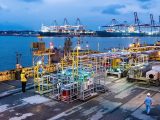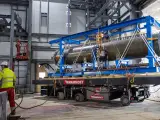
Hydrogen Infrastructure Powers Diesel Fleet Retrofits for Zero-Emission Transport
August 5, 2025In a sunlit workshop just outside Stuttgart, a team of engineers is breathing fresh life into an old diesel heavy-duty truck. Instead of fueling it up with diesel, they’re dropping in some sleek Type IV high-pressure hydrogen tanks and upgrading the fuel management system to handle hydrogen. The end result? A Euro 7–ready hydrogen internal combustion engine (H2-ICE) that can run pure hydrogen or mix it in dual-fuel mode, slashing tailpipe CO₂ to nearly zero and cutting NOₓ by more than 90 %. This isn’t a pipe dream—it’s happening right now, thanks to innovators like Cummins, the EDAG Group, and other trailblazers.
Core News: Retrofitting Goes Mainstream
Between 2024 and 2025, fleets in Europe, North America, and Australia have jumped on pilot programs to swap out diesel for hydrogen setups. Cummins rolled out a heavy hauler equipped with its Euro 7–compliant H2-ICE as part of the HELM modular platform. Over in Germany, the EDAG Group teamed up with Cummins to slot in high-pressure storage and craft plug-&-play retrofit kits. The UK saw ULEMCo test its H2ICED dual-fuel system with Oxfordshire County Council, while Canada’s Hydra Energy is already selling Class 8 co-combustion trucks to commercial fleets. Down under at UNSW Sydney, researchers hit up to 90% hydrogen mix in a diesel engine, chopping CO₂ by over 85% vs. straight diesel.
Technical Dive: H2-ICE Retrofit Mechanics
Turning a regular diesel internal combustion engine into a hydrogen runner isn’t a one-step job. First off, fuel delivery and ignition systems get a complete makeover—hydrogen doesn’t play by diesel’s rules. Teams usually swap in high-pressure, hydrogen-capable injectors and switch from compression ignition to spark ignition. The engine management software then gets rewritten to juggle spark timing, hydrogen flow, and air–fuel ratios. Most crews opt for a lean-burn mix to keep temperatures low and NOₓ in check. The payoff? Almost zero CO₂ when you go full hydrogen, a big win for zero-emission technology.
Dual-Fuel Systems and Flexibility
Not every operator can flip a switch and run on 100% hydrogen overnight. That’s where dual-fuel systems shine. By blending hydrogen with diesel—either injecting it into the air intake or straight into the cylinder—firms like ULEMCo and Hydra Energy can kick out 30–90% of diesel usage. Diesel keeps things reliable under heavy loads, while hydrogen trims the carbon footprint in real time. Fleet managers get to dial in the perfect mix based on fuel availability, routes, or weather, gradually cranking up the hydrogen share without giving up range or grunt.
High-Pressure Storage and Infrastructure Ties
These retrofits wouldn’t work without next-gen hydrogen storage solutions. Most kits lean on Type IV composite tanks that hold hydrogen at 350–700 bar. Wrapped in carbon fiber, they’re lightweight yet tough, delivering enough juice for regional hauls without turning the truck into a brick. EDAG Group’s engineers are even designing modular packs that clip onto existing chassis mounts, making installations as painless as possible. But remember, none of this matters unless the hydrogen infrastructure is there—refueling stations, safety standards, and supply chains all have to scale up in tandem.
Business and Strategic Angle
Why retrofit instead of buying new? It comes down to speed and cash. Brand-new hydrogen or electric rigs can still cost a fortune and have long lead times. Most fleets already have the garages, tools, and diesel-savvy techs in place. By upgrading what’s on hand, companies slash emissions fast and sidestep massive upfront investments. Plus, in regions like the EU and UK—where CO₂ and NOₓ rules are tightening—these kits often qualify for subsidies or green loans. And big OEMs like Cummins hedge their bets by crafting modular H2-ICE platforms that can switch between diesel, hydrogen, or even natural gas depending on local regs and fuel prices.
Company Snapshots
Cummins is leaning into its HELM architecture, rolling out Euro 7–ready H2-ICE units you can swap back to diesel or gas with just a few tweaks. Over in Germany, the EDAG Group is all about integration—designing safe, high-pressure tanks and nailing the certification process. In the UK, ULEMCo is working with local councils to get H2ICED dual-fuel kits road-legal. Canada’s Hydra Energy was first off the mark with commercial Class 8 co-combustion trucks, and at UNSW Sydney in Australia, lab demos hit a 90% hydrogen mix, cutting CO₂ by over 85%. Meanwhile, Clean Logistics is pushing to standardize retrofit protocols across Europe.
Comparisons and Complementary Paths
Retrofits aren’t a silver bullet. Some innovators are going full in with fuel cell electric vehicle (FCEV) retrofit kits, like Safra’s H2-PACK®, which swaps out the whole driveline for fuel cells, batteries, and electric motors. Others focus on scaling green hydrogen production through electrolysis or even pairing retrofits with on-site ammonia cracking in off-grid spots—still pretty experimental. But for many, hybrid and dual-fuel setups are a sensible pitstop where hydrogen supply’s patchy or costs stay high.
Challenges and Roadblocks
Even with all the buzz, rolling out hydrogen retrofits isn’t without headaches. Upfront costs—tens to hundreds of thousands per truck—can blow budgets unless there’s strong financial backing. Installing big tanks eats into cargo space. Rules vary from one country to the next—what flies in Germany might need extra hoops in Canada. And the biggest snag? Pumping enough hydrogen. Outside major corridors, refueling stations are still rare, forcing fleets into tight planning and reserved fills.
Looking Ahead
Still, the momentum’s building. Policymakers, tech firms, and fleet operators are talking more and teaming up. In Europe, projects like Clean Logistics are mapping out common retrofit standards to drive down costs and speed up approvals. North America’s early deployments by Hydra Energy are already undercutting diesel on TCO, according to initial figures. With global pushes for sustainable energy and industrial decarbonization ramping up, these retrofits could bridge the gap to a truly hydrogen-powered transport world. The real test over the next five years will be whether the hydrogen infrastructure build-out can keep pace with all these eager retrofit crews.
Access the study paper here



 With over 15 years of reporting hydrogen news, we are your premier source for the latest updates and insights in hydrogen and renewable energy.
With over 15 years of reporting hydrogen news, we are your premier source for the latest updates and insights in hydrogen and renewable energy.